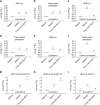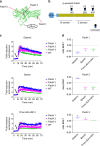Conformational signatures in β-arrestin2 reveal natural biased agonism at a G-protein-coupled receptor
- PMID: 30272007
- PMCID: PMC6123711
- DOI: 10.1038/s42003-018-0134-3
Conformational signatures in β-arrestin2 reveal natural biased agonism at a G-protein-coupled receptor
Abstract
Discovery of biased ligands and receptor mutants allows characterization of G-protein- and β-arrestin-mediated signaling mechanisms of G-protein-coupled receptors (GPCRs). However, the structural mechanisms underlying biased agonism remain unclear for many GPCRs. We show that while Galanin induces the activation of the galanin receptor 2 (Galr2) that leads to a robust stimulation toward Gαq-protein and β-arrestin1/2, an alternative ligand Spexin and its analog have biased agonism toward G-protein signaling relative to Galanin. We used intramolecular fluorescein arsenical hairpin bioluminescence resonance energy transfer-based biosensors of β-arrestin2 combined with NanoBit technology to measure β-arrestin2-Galr2 interactions in real-time living systems. We found that Spexin and Galanin induce specific active conformations of Galr2, which may lead to different internalization rates of the receptor as well as different signaling outputs. This work represents an additional pharmacological evidence of endogenous G-protein-biased agonism at a GPCR.
Conflict of interest statement
The authors declare no competing interests.
Figures








Similar articles
-
Elucidating structural and molecular mechanisms of β-arrestin-biased agonism at GPCRs via MS-based proteomics.Cell Signal. 2018 Jan;41:56-64. doi: 10.1016/j.cellsig.2017.09.013. Epub 2017 Sep 20. Cell Signal. 2018. PMID: 28939107 Review.
-
Beta-arrestin1 and beta-arrestin2 are differentially required for phosphorylation-dependent and -independent internalization of delta-opioid receptors.J Neurochem. 2005 Oct;95(1):169-78. doi: 10.1111/j.1471-4159.2005.03352.x. J Neurochem. 2005. PMID: 16181421
-
Quantifying biased signaling in GPCRs using BRET-based biosensors.Methods. 2016 Jan 1;92:5-10. doi: 10.1016/j.ymeth.2015.04.010. Epub 2015 Apr 15. Methods. 2016. PMID: 25890247
-
Biased receptor functionality versus biased agonism in G-protein-coupled receptors.Biomol Concepts. 2018 Dec 26;9(1):143-154. doi: 10.1515/bmc-2018-0013. Biomol Concepts. 2018. PMID: 30864350 Review.
-
Conformational Profiling of the AT1 Angiotensin II Receptor Reflects Biased Agonism, G Protein Coupling, and Cellular Context.J Biol Chem. 2017 Mar 31;292(13):5443-5456. doi: 10.1074/jbc.M116.763854. Epub 2017 Feb 17. J Biol Chem. 2017. PMID: 28213525 Free PMC article.
Cited by
-
NanoLuc-Based Methods to Measure β-Arrestin2 Recruitment to G Protein-Coupled Receptors.Methods Mol Biol. 2021;2268:233-248. doi: 10.1007/978-1-0716-1221-7_16. Methods Mol Biol. 2021. PMID: 34085273
-
CRISPR-Mediated Protein Tagging with Nanoluciferase to Investigate Native Chemokine Receptor Function and Conformational Changes.Cell Chem Biol. 2020 May 21;27(5):499-510.e7. doi: 10.1016/j.chembiol.2020.01.010. Epub 2020 Feb 12. Cell Chem Biol. 2020. PMID: 32053779 Free PMC article.
-
A novel luminescence-based β-arrestin recruitment assay for unmodified receptors.J Biol Chem. 2021 Jan-Jun;296:100503. doi: 10.1016/j.jbc.2021.100503. Epub 2021 Mar 5. J Biol Chem. 2021. PMID: 33684444 Free PMC article.
-
Genetic code expansion and photocross-linking identify different β-arrestin binding modes to the angiotensin II type 1 receptor.J Biol Chem. 2019 Nov 15;294(46):17409-17420. doi: 10.1074/jbc.RA119.010324. Epub 2019 Sep 17. J Biol Chem. 2019. PMID: 31530642 Free PMC article.
-
Characterization of the chicken melanocortin 5 receptor and its potential role in regulating hepatic glucolipid metabolism.Front Physiol. 2022 Oct 6;13:917712. doi: 10.3389/fphys.2022.917712. eCollection 2022. Front Physiol. 2022. PMID: 36277187 Free PMC article.
References
-
- Pierce KL, Premont RT, Lefkowitz RJ. Seven-transmembrane receptors. Nat. Rev. Mol. Cell Biol. 2007;9:639–650. - PubMed
Associated data
LinkOut - more resources
Full Text Sources
Other Literature Sources

